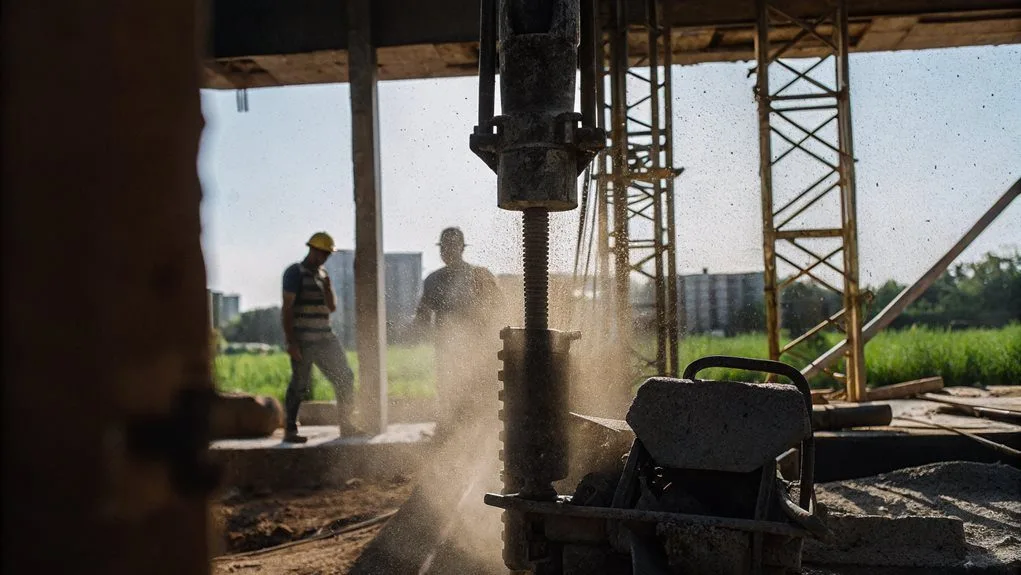So, you want to know the difference between a backhoe and an excavator? Let’s break it down. Backhoes are like Swiss Army knives—great for smaller jobs with their dual-function of digging and loading. Excavators, on the other hand, are serious heavyweights, ideal for deep, extensive digging and tough terrains.
Sure, backhoes zip around the roads, but can they dig deep like excavators? Nope! If you’re curious about which beast suits your project, stick around for more tips!
Key Takeaways
- Excavators are heavier machines designed for extensive digging, while backhoes are versatile equipment ideal for smaller tasks with dual digging and loading capabilities.
- Backhoes can drive on roads for quick site transitions, whereas excavators require trailers for transport and are better suited for uneven terrains.
- Excavators offer greater digging depth (over 6 meters) and precision, while backhoes have a peak digging depth of about 4.3 meters, making them suitable for varied jobs.
- Excavators rotate 360 degrees for enhanced maneuverability in tight corners, compared to backhoes which are limited to about 200 degrees, necessitating repositioning.
- While backhoes are more budget-friendly and multitask effectively, excavators tend to have higher acquisition and operational costs, excelling in large-scale projects.
Size and Design Differences
So, what’s the deal with backhoes and excavators, then? You’ve got excavators, which are the big lads of the machinery world, perfect for heavy-duty jobs like demolition or mining.
Then there’s the backhoe, your compact mate that likes to hang about for smaller tasks.
With their dual-function design, backhoes can dig and load, just not at the same level as those hefty excavators that can rotate 360 degrees—talk about fancy!
And whilst backhoes weigh between 5,400 and 11,300 kg, excavators can pack quite a punch heavier than your ex’s suitcase. Excavators are suited for heavier projects, making them the go-to choice for demanding industrial work. Their tracks provide enhanced stability on uneven terrains, making them ideal for extensive digging tasks.
Urban construction often calls for backhoes, because let’s face it, fitting a giant excavator in a tight space? Good luck with that!
Who knew size really matters?
Mobility and Terrain Handling
When you’re tackling a job site, mobility and terrain handling can make or break your day.
You’ll love backhoes if you need to zip around multiple locations – they can drive on roads at up to 48 km/h. But let’s face it, if the ground gets rocky, don’t expect them to ace the challenge. Backhoes are suitable for big jobs that require more power and speed, making them ideal for extensive construction work. Also, backhoes have a digging depth of 12-16 feet, which allows for versatility in various applications.
Excavators, with their slow, lumbering tracks, sure know how to grip that slippery incline, but moving them between sites? Good luck. You’ll need a trailer and a hefty budget. Oh, and watch where you park that beast; it’s got a knack for demolishing soft ground.
Operational Functions and Efficiency
Choosing the right machine for your job isn’t just about mobility—it’s about what you actually need to do.
You might think backhoes are clever little Swiss Army knives of construction, but they’re no heavy lifters. Need to dig deep? Grab an excavator—it’ll go over 6 metres! Backhoes, on the other hand, peak at about 4.3 metres, so good luck with your dream of becoming an underground digger! And let’s talk versatility. Backhoes are brilliant for switching tasks on a whim, but if you want precision and raw power, excavators are the way to go. Excavators are primarily digging machines and can handle more demanding tasks with ease. Their tracked design provides stability on rough terrain, allowing for efficient digging without repositioning. Sure, they cost more, but who doesn’t fancy a new piece of kit with extra maintenance? Pick wisely, and may the odds be ever in your favour.
Range of Motion and Worksite Flexibility
How often have you found yourself in a tight spot, wishing for a machine that could do it all?
Well, here’s the kicker: excavators can rotate a full 360 degrees.
You can manoeuvre them around tight corners, making them the ideal nimble sidekick.
Backhoes? They can only twist about 200 degrees.
Good luck trying to dig that trench without repositioning!
Sure, backhoes are brilliant for tight urban spots, but if you hit uneven terrain, you might as well pack a picnic instead of working.
Excavators thrive on tricky grounds, but good luck hauling one around a job site.
They’re like that mate who loves to party but needs a flatbed lorry to get anywhere.
Flexibility matters, and it’s no contest! In fact, excavators offer greater reach and digging depth than backhoes, making them more suitable for large-scale projects. Additionally, with trackhoes having over twice the hydraulic capacity of backhoes, they can dig through tougher materials more efficiently.
Cost Implications and Practical Applications
So, you’ve figured out that flexibility on the job site is brilliant and all, but what’s that really worth when it comes to your wallet?
Backhoes are your budget-friendly mates, usually costing R500,000 to R1,300,000+.
Backhoes are your wallet’s best friend, typically priced between R500,000 to R1,300,000+.
Excavators? They’ll burn a hole in your pocket! They’ve got higher acquisition and operational costs.
Hiring a backhoe often keeps your wallet happy too.
Now, if you’re digging deep holes or moving tonnes of dirt, sure, excavators shine.
But for small projects or tight spaces, backhoes rule.
They multitask like a pro, tackling loading and digging without breaking a sweat.
Conclusion
So, there you have it: backhoes and excavators aren’t the same. Who knew, right? Backhoes are like Swiss Army knives—versatile but not always the best for heavy-duty tasks. Excavators, on the other hand, are the hulking giants that’ll dig you out of any mess. If you’re still confused, it’s like choosing between a trusty shovel and a bulldozer—you get what you pay for. Now go forth and dig wisely, my friend! Or just call a professional.






